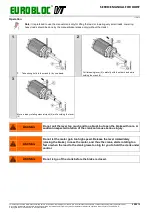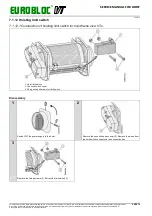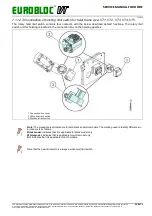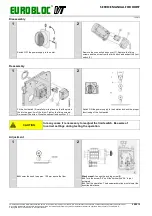
EUROBLOC
SERVICE MANUAL FOR HOIST
114/212
This document and the information contained herein, is the exclusive property of Verlinde S.A.S. and represents a non-public, confidential and proprietary trade secret that
may not be reproduced, disclosed to third parties, altered or otherwise employed in any manner whatsoever without the express written consent of Verlinde S.A.S.
Copyright © (2013) Verlinde S.A.S. All rights reserved.
06/2015
3
4
Check the fixing hole for the axle and the detent arm (12)
• No deformation, oval shape or cracks
• Change the brake rim (14), screws (15)and disc springs
(16)
• Proceed with all other checks as in normal drum brake
service
• Adjust the brake. Refer to the manufacturer’s hoist test
report.
• With every fifth emergency breaking the detent arm and its
shaft has to be changed.
7.1.10 Manual brake release for hoisting motor
CAUTION
The manual brake release is allowed to use only in case of emergency.
DANGER
FOLLOW THE INSTRUCTIONS FOR USAGE CAREFULLY. POTENTIAL ENERGY
OF LOAD WILL HEAT UP THE BRAKE RAPIDLY. OVERHEATED BRAKE CAN
CAUSE UNCONTROLLED LOWERING, ACCELERATING ROTATION SPEED
AND EXPLOSION OF MACHINERY. UNCONTROLLED LOWERING CAN
RESULT SERIOUS INJURY OR DEATH.
CAUTION
It is recommended to contact a service agency authorized by the manufacturer
if there is a need to use manual brake release. Especially trained personnel are
able to ensure the safe lowering of the load.
CAUTION
In hoist models that are equipped with a second brake (optional), both brakes
must be manually opened with levers simultaneously. This requires two
persons to carry out the action.
CAUTION
In hoist models that are equipped with two hoisting motors (and thus two main
brakes), both brakes must be manually opened with levers simultaneously.
This requires two persons to carry out the action.





































